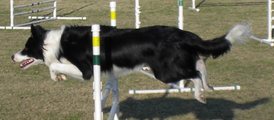Sequencing I Agility Class
This six-week course focuses on distance work on obstacles and learning to sequence smoothly from one obstacle to the next using simple sequences of three to five obstacles. In Sequencing I Agility, students learn to give timely commands, to provide consistent and smooth body cues, and to develop teamwork with their dogs. Handlers also develop the ability to switch smoothly from handling their dogs off one side to handling off the other in the middle of a sequence.
To enroll in Sequencing I Agility, a dog/handler team must meet the General Class Requirements and must have successfully completed a Beginning Agility course, such as our Beginner's Agility course. By the end of the class, all sequencing is performed off-lead, therefore, basic obedience is required for Sequencing I. Your dog must be able to sit, stay, down, and come on command, off-lead with a variety of distractions present.
The cost of our Sequencing I Agility course is $70. You will need to plan on attending one class session each week for six weeks. Each session will last approximately 1½ hours. Each session builds on what was learned in the previous session, so it it best to avoid missing a session if at all possible. You must attend at least 4 sessions to be eligible to graduate. If we have to cancel a session due to weather, etc., you will be notified via phone or e-mail and the class schedule will be adjusted to include a makeup session.
On the last night of Sequencing I students will run a simple course and the instructors will assess their readiness to progress to the next level - Sequencing II.
Requirements for Moving to the Next Level
Upon completing our Sequencing I students must meet the following requiprements in order to move up to our Sequencing II Class.
- Dogs must be able to do simple straight or curved sequences of 3-5 obstacles off leash with no crosses.
- Handlers must call obstacles on time and support the dog with proper hand and body position.
- They should be able to "push to the path" and send dogs to obstacles at a distance of 6-10 feet.
- Targets may begin to be phased out, but rewards and praise should be used.
- All dogs must have a recall with moderate distraction. Dogs that run off, will not be passed on to Sequencing II.
- Dogs should be able to do 6 straight weaves or slightly offset weaves at speed without hesitation. Gates may be used for entry and exit.
- Teeter should be performed at a good rate of speed without hesitation.
Contact Information
To contact WAG for more information visit our Contacts page.
To sign up for one of our classes please review the documents on our Student Documents page, then go to McLennan Community College - Continuing Education, and click on the desired class. One can pay to reserve one's spot in the class on that site.
Visit our Class Location page for directions to our practice field.

